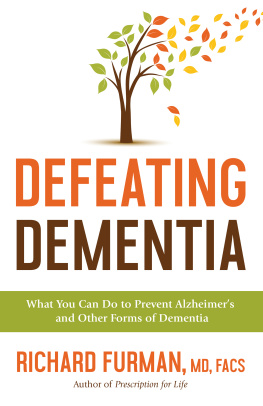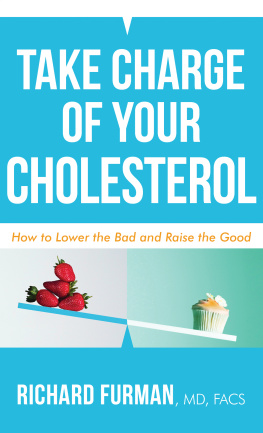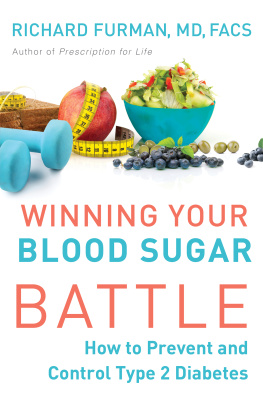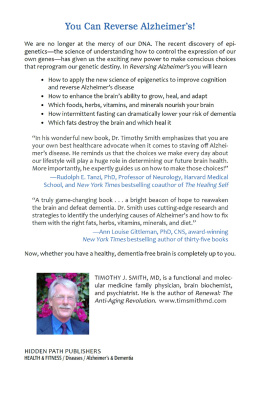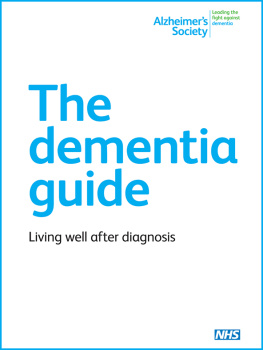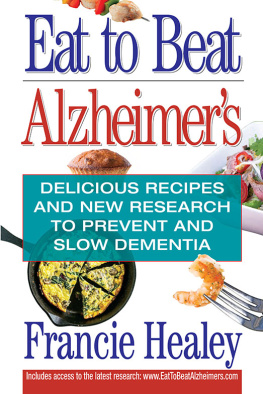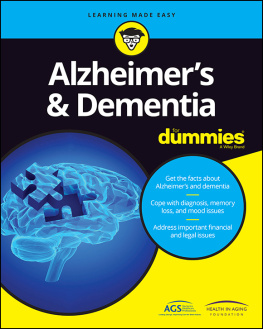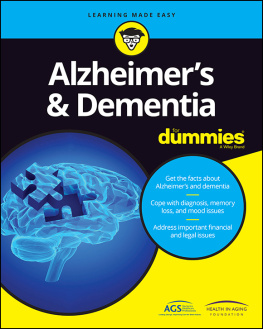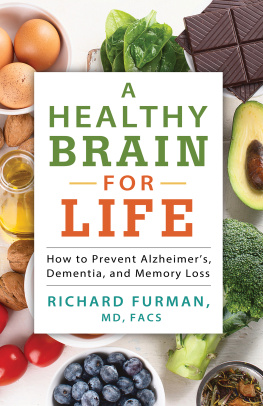Grow old along with methe best is yet to be.
Contents
Cover
Title Page
Copyright Page
Dedication
Epigraph
Foreword by Senator Bill Frist
Foreword by Franklin Graham
Introduction
Part 1: Understanding Dementia
1. What Is Dementia?
2. The Stages of Alzheimers
3. The Brain, Imagery, and Testing
Part 2: The Aging Process and the Health of Your Arteries
4. The Importance of Protecting Your Arteries
5. Midlife and Alzheimers
Part 3: The Risk Factors for Developing Alzheimers
6. Your Course Determines Your Destination
7. Risk Factor 1: High Cholesterol
9. Risk Factor 3: Excess Weight
10. Risk Factor 4: High Blood Pressure
11. Risk Factor 5: Diabetes
Part 4: Lifestyle Choices for Defeating Dementia
12. The Lifestyle Habits We Control
13. Defeating Dementia Lifestyle 1: A Healthy Diet
14. Defeating Dementia Lifestyle 2: Ideal Weight
15. Defeating Dementia Lifestyle 3: Exercise
16. Bonus Lifestyle Choices: Defeating Dementia by Staying Mentally and Socially Active
The Last Leaf
Epilogue
Conclusion
References
About the Author
Back Ads
Back Cover
Foreword
When I was serving as the US Senate majority leader, I regularly traveled with my close friend Dr. Furman on medical missions throughout the world. From responding to medical emergencies such as Hurricane Katrina here at home, to earthquakes in Haiti, to leading medical emergency responses more than a dozen times throughout Africa, we have operated as surgeons side by side. I know him well. He is a man of action. I have witnessed his compassion and his skills as a caregiver operating one-on-one, improving the health of the individual. He now operates in the even larger arena of interpreting the medical literature on prevention for the benefit of us all. His focus today, as so well demonstrated in Defeating Dementia , is to prevent health problems.
As a surgeon, you can touch hundreds, maybe thousandsbut through the dissemination of medical research and public education that can shift behavior you can reach millions. We often hear the phrase an ounce of prevention is worth a pound of cure. When it comes to health that is doubly true, because medical services account for just 10 to 15 percent of our health outcomes. The biggest determinant of health (40 percent) is human behavior: how we eat, live, work, worship, and play. The long-term success of my heart and lung transplant patientsonce we get over the initial hurdle of organ rejectionis largely determined by diet, exercise, tobacco use, and related lifestyle choices.
Most Americans are familiar with actions that can be taken to reduce our risk for heart attack, stroke, cancer, diabetes, and a number of other leading ailments. But what about for Alzheimers disease and related dementias? Every one of us is affected today in some way by Alzheimers dementia, though clearly some much more directly than others. Current trends suggest those connections will grow closer and more painfully personal with the passing of each year. So it makes sense to learn everything we can and take control through action grounded in current medical science to alter the trajectory of those trends. It is our nations sixth leading cause of death, yet few can answer the question, What can be done to prevent cognitive decline?
Within these covers, Dr. Furman tackles this question head-on. He shares what he has gleaned from exhaustively reviewing recent medical literature and presents what changes we can make to lessen our odds of developing Alzheimers, as well as steps to slow the process if it has already begun. The many medical advances in recent years concerning Alzheimers dementia, due to the use of MRI and PET brain studies, shed light on disease development and progression, as beta-amyloid protein accumulates in the brain and kills off cells well before symptoms are apparent. Dr. Furman succinctly translates these brain imaging studies to give readers a profound glimpse of the obscure happenings inside as we watch the obvious outside. Drawing upon his own enlightening observations of his mother-in-law going through the progressive stages of Alzheimers over a fifteen-year period, he writes this compelling treatise to raise our awareness of what we can do at whatever age to counter this devastating process. While many books have been written about individuals with Alzheimers, none has so seamlessly connected the disease biology, the patient experience, and the preventative science as Dr. Furman does so skillfully.
I first read this work, as you will, through the eyes of my own experiences. As a heart specialist and transplant surgeon, I learned what Alzheimers does to the brain, beginning slowly but progressing day by day. In my specialty, it is broadly known that when the arteries that feed the heart become clogged with plaque, the heart muscle begins to progressively fail. Dr. Furman explains the parallel relationship that few others address: the vital connection between the health of the arteries feeding the brain and its normal functioning. Most importantly, he spells out what we can dothe specific, controllable lifestyle steps we can take to improve the supply of nutrients to the brain.
As I think back to our mission trips overseas, it was clear to Dr. Furman and me the overwhelming public health benefit we as Americans enjoy because of prevention. Childhood vaccination efforts have eradicated diseases such as smallpox, measles, and polio. Clean water and sound sanitation systems prevent waterborne illnesses and diarrhea that can be deadly to young children. Safe roads, seat belts, and airbags significantly reduce morbidity and mortality in traffic accidents, and the list goes on. Our approach to cognitive health should be no different. With over five million Americans currently living with Alzheimers, and triple that number projected for 2050, its time for us to consider how to be proactive in addressing this very real threat to public health. With no cure or medication yet developed to halt the progress of this debilitating disease, we must seriously consider lifestyle changes as a first line of defense.

